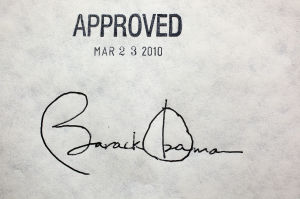Establishing Future Medical Expenses

Obama approves the ACA
This is a critical question for anyone charged with this task. We need to be reasonably certain of our figures. We want to be sure there is enough funding for all that is medically necessary when establishing future medical expenses. We never want a jury and court to consider our figures speculative. Based on the frequent questions swirling around forums, many of us think there is going to be an impact, but just what it will be remains unknown.
As of January 1, 2014, Americans were mandated to have health insurance coverage or pay a fee (the “individual shared responsibility payment”). Health insurance coverage must include 10 service categories called Essential Health Benefits (EBH). These cover:
1) Ambulatory patient services
2) Emergency room services
3) Hospitalization
4) Maternity and newborn care
5) Mental health and substance abuse disorders
6) Prescription drugs
7) Rehabilitative and habilitative services and devices
8) Laboratory services
9) Preventive and wellness services and chronic disease management
10) Pediatric services, including vision and oral care
 There are five categories of health plans available: the bronze, the silver, the gold, the platinum and the catastrophic plan.
There are five categories of health plans available: the bronze, the silver, the gold, the platinum and the catastrophic plan.
The monthly premiums, deductibles, copayments, coinsurance, and out-of-pocket maximums vary depending on the plan chosen. People age 30 and over with a “hardship exemption” may buy a catastrophic plan. There are 14 types of hardship exemptions.
Available at this link, there are state-specific Essential Health Benefits benchmark plans.
Collateral sources when establishing future medical expenses
Conforming to state statutes, attorneys, life care planners, and legal nurse consultants agree, although some more reluctantly than others, collateral sources should not to be considered when establishing future medical expenses. Exclusion of the plaintiff’s benefits and insurance is based on the common law collateral source rule which indicates the tortfeasor is responsible for making the plaintiff whole.
In other words, plaintiffs do not need to factor in any health insurance benefits they have to offset their awards for future medical expenses.
Up until recently, if a liability trial was held in a collateral source rule state, the jury was not permitted to learn of any offset the plaintiff may have.
However, the majority of states in the U.S. have now modified the collateral source rule in some form. The American Tort Reform Association (ATRA) has a map at this site. By clicking on a particular state, we can learn the specific modifications made in that state.
Key cases involving establishing future medical expenses
Court decisions in the last few years have made key determinations involving damages and establishing future medical expenses. The Howell v. Hamilton Meats (2011) 52 Cal. 4th 541 decision changed the way costs for medical care are to be recovered.
This decision held that a plaintiff could only recover the amounts paid for past medical treatment, rather than what was billed. This set a precedent for how charges resulting from the injury should be considered, but it did not say how to establish future medical costs. See this link.
In 2012, The College of Holy Cross Department of Economics Faculty issued a paper entitled: Potential Effects of the Affordable Care Act on the Award of Life Care Expenses. The authors concluded that the ACA should make calculations in life care plans simple by limiting costs to premiums and out of pocket limits minus any pre injury expected medical costs and penalties if uninsured. This opinion does not consider services and items which are necessary but not covered or severely limited by health plans. Home care is one important service that comes to mind. Therefore, this opinion leaves us with many questions; it is not a simple calculation.
In Corenbaum v. Lampkin (2013) 215 Cal. App. 4th 1308, the court held that the billed amounts for past medical treatments were not admissible at trial. The court held that:
1. The full amount billed for past medical services is not relevant to the amount of future medical expenses and is inadmissible for that purpose.
2. Evidence of the full amount billed for past medical services cannot support an expert opinion on the reasonable value of future medical services.
3. Evidence of the full amount billed for past medical services is not admissible to determine the amount of noneconomic damages. See this link.
Now that the ACA is in place and upheld by the Supreme Court, we’ll have to see what future courts decide. We need to be aware of any further decisions as we estimate future damages. We need to learn if health plan premiums, deductibles, copayments, coinsurance, and out-of- pocket maximums can be predicted.

Linda Husted
Linda Husted, MPH, RN, CNLCP, LNCC, CCM, CDMS, CRC shared her expertise about life care planning during the Falls course, now available on demand. Get all the details at this link.
